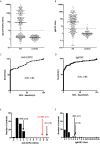Autoantibodies in Rheumatoid Arthritis - Laboratory and Clinical Perspectives
- PMID: 34054878
- PMCID: PMC8161594
- DOI: 10.3389/fimmu.2021.685312
Autoantibodies in Rheumatoid Arthritis - Laboratory and Clinical Perspectives
Abstract
Measurement of two groups of autoantibodies, rheumatoid factor (RF) and anti-citrullinated protein/peptide antibodies (ACPA) have gained increasing significance in the diagnosis and classification of rheumatoid arthritis (RA) over the last 65 years. Despite this rising importance of autoimmune serology in RA, there is a palpable lack of harmonization between different commercial RF and ACPA tests. While a minimal diagnostic specificity has been defined for RF tests, which almost always are related to an international reference preparation, neither of this applies to ACPA. Especially assays with low diagnostic specificity are associated with very low positive predictive values or post-test probabilities in real world settings. In this review we focus on issues of practical bearing for the clinical physician diagnosing patients who potentially have RA, or treating patients diagnosed with RA. We advocate that all clinically used assays for RF and ACPA should be aligned to a common diagnostic specificity of 98-99% compared to healthy controls. This high and rather narrow interval corresponds to the diagnostic specificity seen for many commercial ACPA tests, and represents a specificity that is higher than what is customary for most RF assays. Data on antibody occurrence harmonized in this way should be accompanied by test result-specific likelihood ratios for the target diagnosis RA on an ordinal or interval scale, which will provide the clinical physician with more granular and richer information than merely relating numerical values to a single cut-off point. As many physicians today are used to evaluate autoantibodies as positive or negative on a nominal scale, the introduction of test result-specific likelihood ratios will require a change in clinical mindset. We also discuss the use of autoantibodies to prognosticate future arthritis development in at-risk patients as well as predict severe disease course and outcome of pharmacological treatment.
Keywords: ACPA; anti-CCP; diagnosis; prognosis; rheumatoid arthritis; rheumatoid factor.
Copyright © 2021 Rönnelid, Turesson and Kastbom.
Conflict of interest statement
JR has been a member of the scientific advisory board for Thermo Fisher Scientific, and has research collaboration with the diagnostic companies Thermo Fischer Scientific, Inova Diagnostics, Euroimmun and Theradiag. CT has received a research grant from Bristol-Myers Squibb, consultancy fees from Roche, and speaker’s honoraria from Abbvie, Bristol-Myers Squibb, Nordic Drugs, Pfizer and Roche. AK has received speaker’s honoraria from Werfen and was previously employed by Sanofi. The handling editor declared a past co-authorship with one of the authors, JR.
Figures



Similar articles
-
Performance characteristics of rheumatoid factor and anti-cyclic citrullinated peptide antibody assays may impact ACR/EULAR classification of rheumatoid arthritis.Ann Rheum Dis. 2018 May;77(5):667-677. doi: 10.1136/annrheumdis-2017-212365. Epub 2018 Jan 23. Ann Rheum Dis. 2018. PMID: 29363510
-
Determination of Autoantibody Isotypes Increases the Sensitivity of Serodiagnostics in Rheumatoid Arthritis.Front Immunol. 2018 Apr 24;9:876. doi: 10.3389/fimmu.2018.00876. eCollection 2018. Front Immunol. 2018. PMID: 29740454 Free PMC article.
-
Only rheumatoid factor-positive subset of anti-citrullinated peptide/protein antibody-negative rheumatoid arthritis may seroconvert to anti-citrullinated peptide/protein antibody-positive.Int J Rheum Dis. 2017 Jun;20(6):731-736. doi: 10.1111/1756-185X.13000. Epub 2017 Feb 15. Int J Rheum Dis. 2017. PMID: 28198158
-
Biomarkers for early diagnosis of rheumatoid arthritis.Clin Chim Acta. 2025 Jun 15;574:120288. doi: 10.1016/j.cca.2025.120288. Epub 2025 Apr 10. Clin Chim Acta. 2025. PMID: 40220982 Review.
-
Should rheumatoid factor in rheumatoid arthritis be sent to Davy Jones's Locker?Scand J Rheumatol. 2012 Mar;41(2):85-8. doi: 10.3109/03009742.2011.617316. Epub 2012 Jan 3. Scand J Rheumatol. 2012. PMID: 22211313 Review.
Cited by
-
Galangin: A Promising Flavonoid for the Treatment of Rheumatoid Arthritis-Mechanisms, Evidence, and Therapeutic Potential.Pharmaceuticals (Basel). 2024 Jul 19;17(7):963. doi: 10.3390/ph17070963. Pharmaceuticals (Basel). 2024. PMID: 39065811 Free PMC article. Review.
-
Biological mechanisms of pulmonary inflammation and its association with seropositive rheumatoid arthritis.Front Immunol. 2025 May 23;16:1530753. doi: 10.3389/fimmu.2025.1530753. eCollection 2025. Front Immunol. 2025. PMID: 40486510 Free PMC article. Review.
-
Rheumatoid Arthritis: Pathogenic Roles of Diverse Immune Cells.Int J Mol Sci. 2022 Jan 14;23(2):905. doi: 10.3390/ijms23020905. Int J Mol Sci. 2022. PMID: 35055087 Free PMC article. Review.
-
New Therapeutic Strategies for the Inflammatory Rheumatoid Arthritis Disease: Emphasizing Mesenchymal Stem Cells and Associated exo-miRNA or exo-lncRNA.Cell Biochem Biophys. 2024 Sep;82(3):1599-1611. doi: 10.1007/s12013-024-01316-7. Epub 2024 May 31. Cell Biochem Biophys. 2024. PMID: 38822204 Review.
-
A Tool to Eliminate IgM Immunoassay Interference.AAPS J. 2025 Apr 11;27(3):76. doi: 10.1208/s12248-025-01067-0. AAPS J. 2025. PMID: 40216709
References
-
- Bennett GA, Cobb S, Jacox R, Jessar RA, Ropes MW. Proposed Diagnostic Criteria for Rheumatoid Arthritis. Bull Rheum Dis (1956) 7(4):121–4. - PubMed
Publication types
MeSH terms
Substances
LinkOut - more resources
Full Text Sources
Other Literature Sources
Medical
Research Materials

